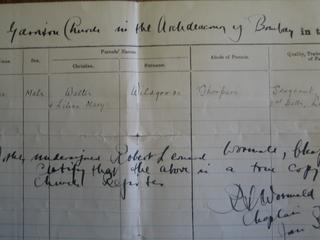The family reunited
from the Archdeaconry of Bombay, January 1923
Walter recovered from his bout with typhoid fever at the Convalescent Camp in the Nilgiri Hills near Bangalore. May arrived with Douglas, the son he'd never seen, while he was recuperating. Walter and May hadn't seen each other since the death of young Walter, and now Walter faced the somewhat daunting task of getting to know Doug. This from Walter's letters:
I stayed there [Nilgiri Hills] until February 1922 and during my stay there, May had arrived in Poona with Douglas who was then 2 years of age. Married quarters were found for her, and she had the assistance of a Cook Ayah. She is a native woman who are really devoted to the wives of the soldiers. She used to look after young Douglas, and take him out in his pushchair. I returned to the regiment in February, shortly after May’s arrival, and young Doug didn’t like me talking and making a fuss of his mother, as he have never seen me before. He was born on the 12 January 1920, and I was in Secunderabad at that time.
Things settled to a normal routine for the Wildgooses. And another baby was on the way.
The year passed by, and I was getting much stronger, as I was in a weak state after such a long stay in Hospital and the Convalescent Camp. It was 1922 now, and in December 1922, May had to go to hospital to give birth to Cyril Maurice on the 22nd December, but unfortunately he was born with a “double hare-lip” and a cleft palate. So May’s troubles began all over, and in March 1923, I had to conduct her back to England with Cyril for him to receive hospital treatment. I stayed in England until September, when I had to return to India to rejoin my unit. The regiment had moved to Dinapore during my absence. It was a flat country, a rice growing province, and very damp. This was now October 1923, and I resumed my duties as usual.
I received notice that May would be arriving in Bombay in 1924 as the child was found fit to travel to India with May. I went to Bombay to bring her to Dinapore. It was a long train journey and the little chap developed diarrohea, and on arrival in Dinapore he was immediately placed in the hospital. It was not long afterwards that poor little Cyril passed away and he had to be buried the same day as he dies, as that was the custom in India.
Poor May, she has had some hardships! We left Dinapore to go to Lucknow in November 1924, and we had to get settled down once more in new surroundings. Everyone had the same experience. A soldier’s life!
From my research, I understand that the death of children and spouses who traveled to India from England was nothing out of the ordinary. One journal noted that there were always stacks of small coffins at the termination points of the rail lines leading to British military camps - ready to accommodate the children who'd died on the long, hot train trip across the country.


0 Comments:
Post a Comment
Subscribe to Post Comments [Atom]
<< Home